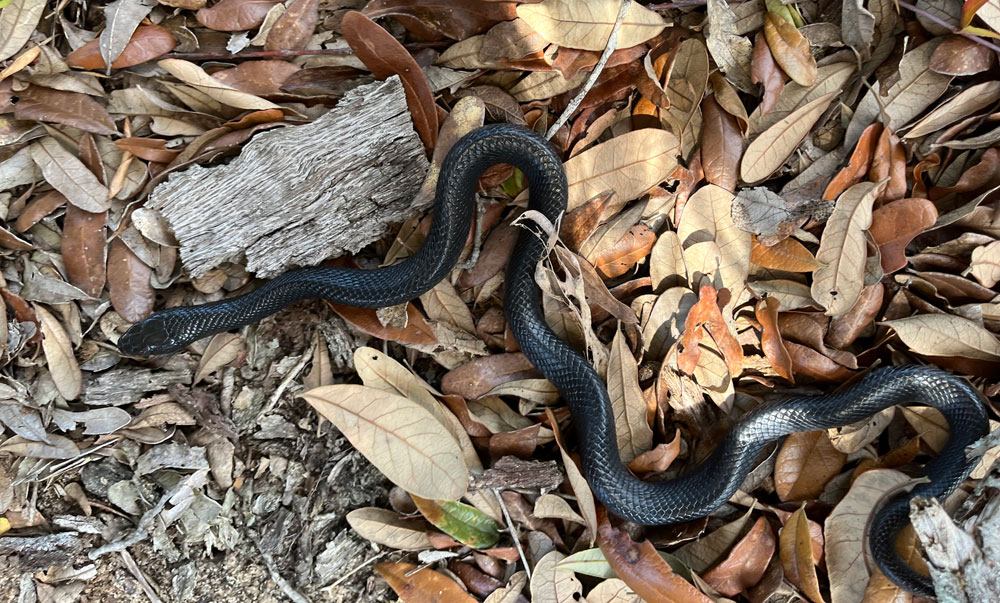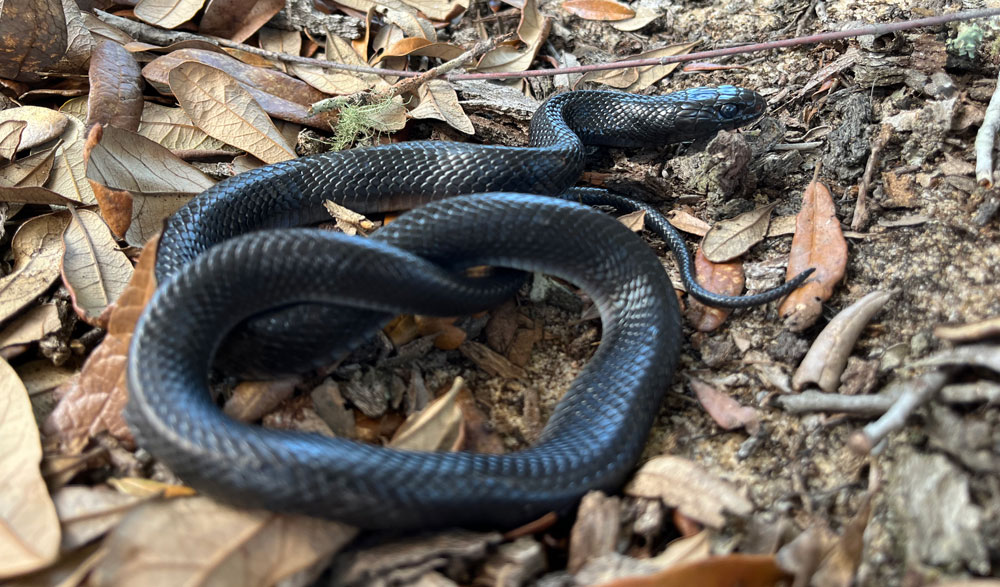The discovery of two wild-born Eastern indigo snake hatchlings is very encouraging. It indicates we are successfully reestablishing the species where it once occurred
Two Eastern indigo snake (Drymarchon couperi) hatchlings, the offspring of released captive-bred specimens, were observed at the Apalachicola Bluffs and Ravines Preserve (ABRP) in Bristol, Florida. The hatchlings show that the captive breeding efforts between The Nature Conservancy (TNC), the Central Florida Zoo & Botanical Gardens’ Orianne Center for Indigo Conservation (OCIC), the Florida Fish and Wildlife Conservation Commission (FWC), U.S. Fish and Wildlife Service (FWS), Welaka National Fish Hatchery, The Orianne Society, Joseph W. Jones Ecological Research Center, Southern Company through the National Fish and Wildlife Foundation (NFWF), and the Fish & Wildlife Foundation of Florida.

Eastern indigo snake hatchling at Apalachicola Bluffs and Ravines Preserve Photo (c) Michelle Hoffman/Orianne Center for Indigo Conservation, Central Florida Zoo used with permission
“The discovery of two wild-born Eastern indigo snake hatchlings is very encouraging. It indicates we are successfully reestablishing the species where it once occurred,” Michele Elmore, Fish and wildlife biologist with the U.S. Fish and Wildlife Service, said in a statement released to the media. “It’s exciting too, as we are celebrating the 50th anniversary of the Endangered Species Act, enacted in 1973 to prevent the loss of endangered and threatened species and preserve the places they live. This Eastern indigo snake recovery program is an excellent example of the power of partnerships to recover species,” Elmore said.
The recovery effort for this species at the site began in 2017. Since 2017, 126 Eastern Indigo snakes have been released in the Apalachicola Bluffs and Ravines Preserve. Ten males and nine females were released at the site in April of this year.
“Bringing a species back from the brink is reliant on functional ecosystems, like the longleaf pine and wiregrass habitat at The Nature Conservancy’s Apalachicola Bluffs and Ravines Preserve,” said Preserve Manager Catherine Ricketts, The Nature Conservancy in Florida. “The discovery of two Eastern indigo hatchlings demonstrates that 40-plus years of restoration and management work by TNC and partners has created a place where Eastern indigo snakes are now beginning to build self-sustaining populations.”
Eastern Indigo Snake Information
The Eastern indigo snake is the longest native snake in the United States, sometimes reaching more than 8 feet in length. The snake is a federally threatened species and certain restrictions are in place with regard to possessing them. A member of the Colubridae family, indigo snakes feed on a variety of animals, including small mammals, amphibians, birds, lizards, baby turtles, and other snakes, including every species of venomous snake found in Florida.
12 Eastern Indigo Snakes Released In Northern Florida
Climbing A Tree To Save An Eastern Indigo Snake
The snake was historically found in southern Georgia, Alabama, eastern Mississippi and throughout much of Florida, but was largely extirpated from the ABRP due to habitat loss and fragmentation. The last sighting of an Eastern indigo in the ABRP prior to these latest release efforts occurred in 1982. The Apalachicola Bluffs and Ravines Preserve is the only area designated by the state for the introduction of the indigo snake.


